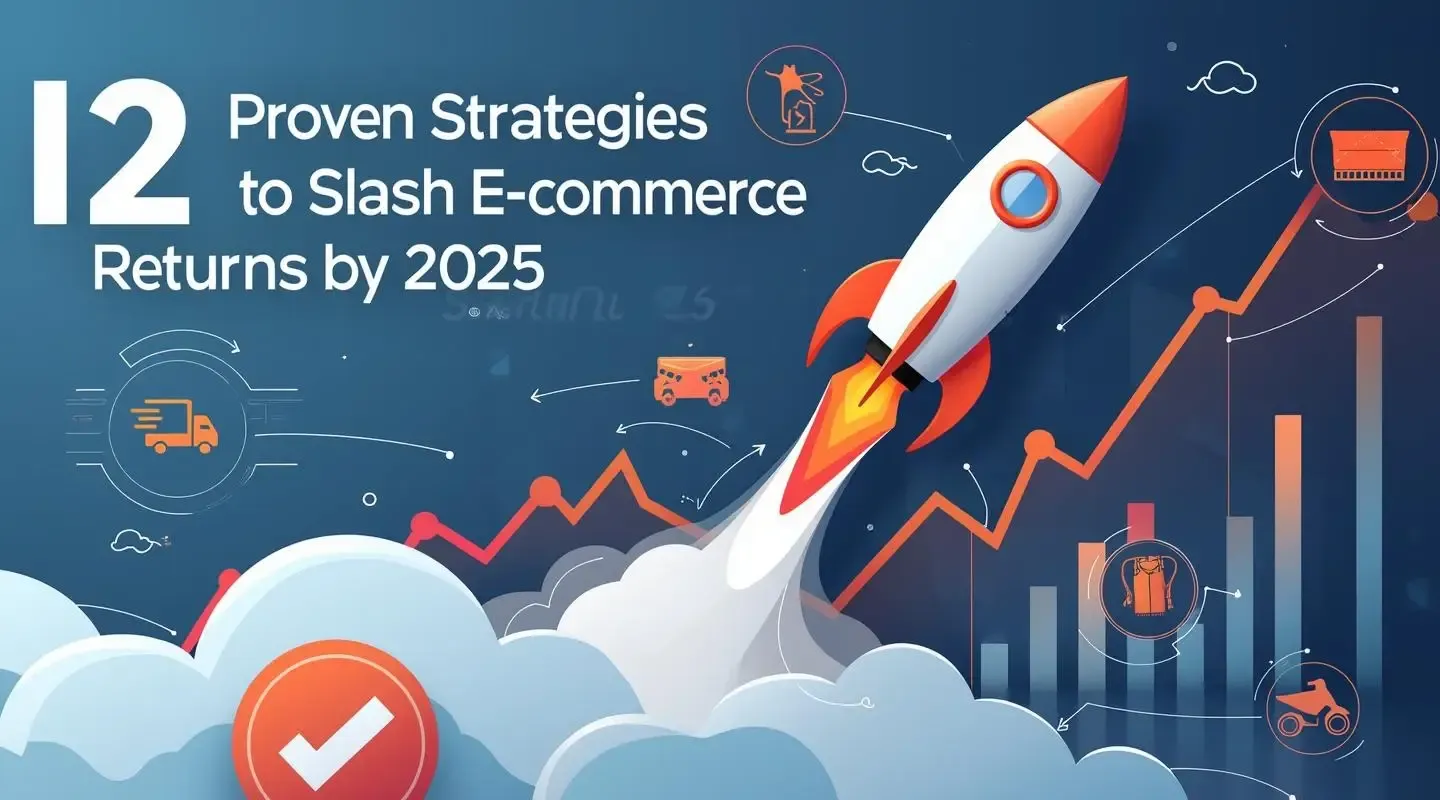Ecommerce return rates have reached unprecedented levels in 2025, with the average online return rate climbing to 16.9%—nearly double the 8.9% rate for brick-and-mortar stores. This dramatic increase represents both a challenge and an opportunity for online retailers, as understanding and managing return rates becomes critical for profitability and customer satisfaction.
The surge in return rates isn't simply a negative trend to combat. Modern consumers view generous return policies as essential trust signals, with 92% of customers saying they're more likely to purchase from retailers with easy return processes. The key lies in understanding what drives returns in your specific category and implementing targeted strategies to reduce unnecessary returns while maintaining customer confidence.
This comprehensive analysis examines 2025 return rate data across all major ecommerce categories, identifies the primary drivers behind high return rates, and provides actionable strategies for optimizing your return rates without sacrificing customer satisfaction. Whether you're benchmarking your current performance or developing strategies to improve, this data-driven guide provides the insights you need to make informed decisions.
Overall Ecommerce Return Rate Trends
2025 Industry Benchmarks
The overall ecommerce return rate of 16.9% represents a 23% increase from 2023 levels, driven by multiple factors including increased online shopping adoption, changing consumer expectations, and category mix shifts toward higher-return products like fashion and home goods.
This increase isn't uniform across all retailers or categories. Leading ecommerce companies with sophisticated return management systems maintain return rates 34% below industry averages, while retailers with poor return experiences see rates up to 47% above average. This disparity highlights the critical importance of return management strategy and execution.
The growth in return rates correlates strongly with overall ecommerce growth, suggesting that as more consumers shift to online shopping, they're bringing return behaviors that were previously limited to physical stores. First-time online shoppers in categories like furniture and appliances show return rates 67% higher than experienced online buyers.
Regional variations are significant, with urban markets showing return rates 28% higher than rural areas. This difference reflects factors including delivery speed expectations, product availability for comparison, and demographic differences in shopping behavior and return tolerance.
Seasonal Return Rate Patterns
Return rates show dramatic seasonal variations that retailers must plan for in inventory management, staffing, and cash flow planning. Understanding these patterns helps optimize operations and set appropriate expectations.
Holiday Season Impact (November-January)
Holiday return rates peak at 24.3% in December, driven by gift purchases where recipients have different preferences than purchasers. The post-holiday return surge in January reaches 31.2%, creating operational challenges for retailers unprepared for the volume spike.
Gift returns show different patterns than personal purchases, with higher rates of exchanges rather than refunds and longer processing times due to gift receipt procedures. Retailers offering gift receipts and extended holiday return periods see 43% higher customer satisfaction scores during this period.
Back-to-School Season (July-September)
Back-to-school shopping drives return rates to 19.7% in August, primarily in clothing, electronics, and school supplies categories. Size-related returns dominate this period as parents purchase items for growing children without trying them on.
Spring Cleaning Period (March-May)
Home goods and organization products see elevated return rates during spring months, reaching 21.4% in April. This pattern reflects seasonal purchasing of items that may not fit existing spaces or meet functional requirements upon delivery.
Channel-Specific Return Rate Analysis
Different sales channels show dramatically different return rate patterns, reflecting varying customer expectations, product presentation capabilities, and purchase decision processes.
Direct-to-Consumer (DTC) Brands: 14.2% Average
DTC brands typically maintain lower return rates due to better product education, customer communication, and brand loyalty. However, newer DTC brands without established customer bases see return rates approaching 22%.
Marketplace Platforms: 18.7% Average
Marketplace sales show higher return rates due to inconsistent seller quality, varying product descriptions, and customer uncertainty about seller reliability. Amazon's return rate of 15.3% demonstrates the impact of standardized processes and customer trust.
Social Commerce: 23.1% Average
Social media-driven purchases show the highest return rates, reflecting impulse buying behavior and limited product information available through social platforms. Instagram and TikTok commerce particularly struggle with high return rates.
Mobile Commerce: 19.4% Average
Mobile purchases show elevated return rates compared to desktop purchases, attributed to smaller screens limiting product detail review and higher impulse purchase rates on mobile devices.
Category-Specific Return Rate Analysis
Fashion and Apparel: 24.4% Return Rate
Fashion maintains the highest return rates across all ecommerce categories, driven by fit issues, style preferences, and the tactile nature of clothing that's difficult to evaluate online.
Subcategory Breakdown:
- Women's Fashion: 27.8% (highest in all ecommerce)
- Men's Fashion: 19.2%
- Children's Clothing: 22.1%
- Shoes: 31.4% (highest subcategory overall)
- Accessories: 16.7%
Primary Return Reasons:
Size and fit issues account for 67% of fashion returns, with "too small" being the most common complaint at 34% of all returns. Style and color dissatisfaction represents 23% of returns, while quality issues account for 10%.
Seasonal Variations:
Fashion return rates peak during back-to-school (August) at 29.7% and holiday seasons (December) at 31.2%. Summer months show the lowest rates at 21.3%, attributed to simpler clothing styles and better size consistency in warm-weather apparel.
Size-Specific Patterns:
Plus-size clothing shows return rates of 34.2%, significantly higher than standard sizes, reflecting limited size availability and inconsistent sizing across brands. Petite sizes show similar elevation at 31.7%.
Brand Category Differences:
Fast fashion brands average 28.9% return rates compared to 21.4% for premium brands, reflecting quality differences and customer expectations. Luxury fashion shows the lowest rates at 18.7% due to higher purchase consideration and better quality control.
Electronics and Technology: 11.8% Return Rate
Electronics show relatively low return rates due to standardized specifications and customer research behavior, but high average return values make this category critical for profitability management.
Subcategory Analysis:
- Smartphones: 8.4%
- Laptops: 12.7%
- Gaming Equipment: 15.3%
- Smart Home Devices: 14.9%
- Audio Equipment: 13.2%
Return Reason Distribution:
Defective or damaged items account for 43% of electronics returns, significantly higher than other categories. Compatibility issues represent 28% of returns, while customer dissatisfaction with performance accounts for 19%.
Price Point Impact:
Electronics under $100 show return rates of 15.7%, while items over $1,000 show rates of only 8.9%. This inverse relationship reflects increased purchase consideration for higher-value items and better customer research.
Technical Complexity Correlation:
Simple electronics (cables, basic accessories) show return rates of 18.3%, while complex items requiring setup (smart home systems, professional equipment) show rates of 23.7% due to installation and compatibility challenges.
Home and Garden: 18.9% Return Rate
Home goods show elevated return rates due to size, style, and functional fit challenges that are difficult to assess online.
Category Breakdown:
- Furniture: 22.7%
- Home Decor: 19.4%
- Kitchen Appliances: 15.8%
- Garden Equipment: 14.2%
- Bedding and Bath: 21.3%
Size and Space Issues:
Furniture returns are dominated by size and space fit problems, accounting for 58% of all furniture returns. "Larger than expected" represents 34% of furniture returns, while "doesn't fit space" accounts for 24%.
Style and Aesthetic Returns:
Home decor shows high rates of style-related returns at 47% of all returns, reflecting the subjective nature of aesthetic preferences and difficulty conveying style through online images.
Assembly and Installation Challenges:
Products requiring assembly show return rates 67% higher than ready-to-use items, with "too difficult to assemble" being a common return reason for furniture and equipment.
Beauty and Personal Care: 12.3% Return Rate
Beauty products show moderate return rates despite hygiene restrictions, with color matching and skin sensitivity being primary concerns.
Product Type Variations:
- Makeup: 15.7%
- Skincare: 11.2%
- Hair Care: 9.8%
- Fragrances: 14.3%
- Tools and Accessories: 8.9%
Color Matching Challenges:
Makeup returns are dominated by color matching issues, representing 52% of all makeup returns. Foundation and concealer show the highest return rates at 23.4% due to shade selection difficulties.
Skin Sensitivity and Allergies:
Skincare returns due to allergic reactions or skin sensitivity account for 34% of skincare returns, highlighting the importance of ingredient disclosure and patch testing recommendations.
Fragrance Preference Subjectivity:
Perfume and cologne returns show high rates due to scent preference subjectivity, with "doesn't smell as expected" accounting for 67% of fragrance returns.
Books, Media, and Entertainment: 7.2% Return Rate
Books and media show the lowest return rates across all categories due to clear content expectations and standardized formats.
Format Differences:
- Physical Books: 5.8%
- E-books: 3.2%
- DVDs/Blu-rays: 8.7%
- Video Games: 11.4%
- Educational Materials: 9.3%
Content Satisfaction:
Unlike other categories, books show high satisfaction rates with only 23% of returns due to content dissatisfaction. Most returns (67%) are due to shipping damage or ordering errors.
Educational Material Patterns:
Textbooks and educational materials show seasonal return spikes aligned with academic calendars, with return rates reaching 15.7% at semester starts due to course changes and requirement updates.
Return Rate Drivers and Root Causes
Product Description and Photography Issues
Poor product presentation remains the leading driver of avoidable returns across all categories, accounting for an estimated 34% of all return volume.
Photography Quality Impact:
Products with professional, multi-angle photography show return rates 23% lower than those with basic product images. 360-degree product views reduce return rates by an additional 15% for applicable products.
Size and Scale Communication:
Products without clear size references (models, everyday objects, measurements) show return rates 45% higher than those with comprehensive size information. This impact is particularly pronounced in furniture (67% higher) and clothing (52% higher).
Color Accuracy:
Color-critical products (fashion, home decor, beauty) with poor color accuracy in photography show return rates up to 78% higher than those with color-accurate images. Professional color calibration and multiple lighting conditions significantly reduce color-related returns.
Feature and Benefit Communication:
Products with comprehensive feature descriptions and benefit explanations show return rates 31% lower than those with basic specifications only. Video demonstrations reduce return rates by an additional 19% for complex products.
Customer Expectations vs. Reality Gaps
Misaligned customer expectations drive significant return volume, particularly in categories where online evaluation is challenging.
Quality Perception Mismatches:
Products perceived as lower quality than expected based on price and description drive 28% of quality-related returns. Clear material descriptions and realistic quality positioning reduce these returns significantly.
Functionality Misunderstandings:
Complex products with unclear functionality descriptions show return rates 56% higher than those with clear use case explanations and limitations. This is particularly important for electronics and home improvement products.
Delivery and Packaging Expectations:
Products arriving in poor packaging or with longer-than-expected delivery times show elevated return rates due to negative first impressions, even when the product itself meets expectations.
Size and Fit Challenges
Size-related returns represent the largest single category of avoidable returns, particularly in fashion and home goods.
Sizing Inconsistency:
Brands with inconsistent sizing across products show return rates 43% higher than those with standardized sizing. Size chart accuracy and consistency are critical for reducing fit-related returns.
Fit Prediction Tools:
Retailers using AI-powered fit prediction tools see size-related return reductions of 27% on average. Virtual try-on technology shows even greater impact with 34% reduction in fit-related returns.
Customer Education:
Detailed sizing guides, fit videos, and customer review integration reduce size-related returns by 31% compared to basic size charts alone.
Strategies for Optimizing Return Rates
Product Presentation Enhancement
Improving product presentation represents the highest-impact strategy for reducing return rates while maintaining customer satisfaction.
Photography and Visual Content Strategy:
Implement comprehensive photography standards including multiple angles, lifestyle shots, detail close-ups, and scale references. For fashion, include diverse model sizes and styling options. For home goods, show products in realistic room settings with clear scale indicators.
Video Content Integration:
Develop product videos showing functionality, assembly processes, and real-world usage. Fashion videos should include movement and different lighting conditions. Electronics videos should demonstrate setup and key features.
Interactive Content Development:
Implement 360-degree product views, zoom functionality, and interactive features that allow customers to explore products thoroughly before purchase. AR try-on features for applicable categories show significant return rate reductions.
User-Generated Content Integration:
Encourage and showcase customer photos and videos in product reviews. Real customer content provides authentic perspectives on fit, quality, and functionality that professional content cannot replicate.
Size and Fit Optimization
Addressing size and fit challenges requires comprehensive strategies combining technology, education, and policy optimization.
Advanced Sizing Tools:
Implement AI-powered size recommendation engines that consider customer measurements, purchase history, and product-specific fit characteristics. Virtual fitting rooms and try-on technology show significant impact for fashion and eyewear categories.
Comprehensive Size Education:
Develop detailed sizing guides with measurement instructions, fit videos, and comparison tools. Include customer review integration that highlights fit feedback and size recommendations from verified purchasers.
Flexible Exchange Policies:
Offer free size exchanges to encourage customers to find the right fit rather than requesting refunds. Size exchange programs typically show 67% higher customer retention than standard return policies.
Fit Guarantee Programs:
Consider implementing fit guarantee programs for high-return categories, offering free returns and exchanges until customers find the right size. While this may increase short-term return volume, it typically improves long-term customer satisfaction and retention.
Customer Education and Expectation Management
Proactive customer education reduces return rates by ensuring customers make informed purchase decisions.
Detailed Product Information:
Provide comprehensive product specifications, use cases, limitations, and care instructions. Include compatibility information for electronics and assembly requirements for furniture.
Customer Review Integration:
Implement robust review systems that highlight common customer concerns, fit feedback, and usage experiences. Encourage detailed reviews that help future customers make informed decisions.
Pre-Purchase Consultation:
Offer chat support, virtual consultations, or phone assistance for complex or high-value purchases. Personal consultation reduces return rates by helping customers select appropriate products.
Educational Content Marketing:
Develop buying guides, how-to content, and educational resources that help customers understand product categories and make informed decisions. This content also improves SEO and customer engagement.
Technology-Driven Solutions
Advanced technology solutions can significantly impact return rates while improving customer experience.
AI-Powered Recommendations:
Implement machine learning algorithms that analyze customer behavior, purchase history, and product characteristics to recommend products with higher satisfaction probability.
Predictive Analytics:
Use data analytics to identify customers and products with high return probability, enabling proactive intervention through additional education, consultation, or targeted policies.
Virtual Try-On and AR:
Implement augmented reality solutions for applicable categories including fashion, eyewear, furniture, and home decor. These technologies show significant return rate reductions by improving purchase confidence.
Chatbot and AI Support:
Deploy intelligent chatbots that can answer product questions, provide sizing assistance, and help customers make informed decisions before purchase.
Industry Best Practices and Case Studies
Successful Return Rate Optimization Examples
Leading retailers have implemented comprehensive strategies that significantly reduce return rates while maintaining or improving customer satisfaction.
Case Study: Fashion Retailer Reduces Returns by 34%
A major online fashion retailer implemented a comprehensive return reduction strategy including AI-powered size recommendations, virtual try-on technology, and enhanced product photography. The initiative reduced return rates from 28.7% to 18.9% while improving customer satisfaction scores by 23%.
Key implementation elements included machine learning algorithms analyzing customer measurements and purchase history, 360-degree product photography with diverse model representation, virtual fitting room technology for key product categories, and comprehensive size guides with video demonstrations.
Results showed 34% reduction in overall return rates, 67% reduction in size-related returns specifically, 23% improvement in customer satisfaction scores, and $4.2 million annual savings in return processing costs.
Case Study: Electronics Retailer Improves Product Education
An electronics retailer focused on improving product education and customer support to reduce compatibility and functionality-related returns. The strategy included detailed compatibility guides, video demonstrations, and pre-purchase consultation services.
Implementation included comprehensive compatibility databases with search functionality, product demonstration videos showing setup and key features, live chat support with technical specialists, and detailed FAQ sections addressing common concerns.
Results included 28% reduction in compatibility-related returns, 45% reduction in customer support tickets, 31% improvement in customer satisfaction with technical products, and 15% increase in average order value due to improved customer confidence.
Case Study: Home Goods Retailer Implements AR Visualization
A furniture and home decor retailer implemented augmented reality visualization tools allowing customers to see products in their actual spaces before purchase. This technology significantly reduced size and style-related returns.
The implementation included AR mobile app allowing furniture placement in customer spaces, room design consultation services, detailed measurement guides and space planning tools, and customer review integration highlighting space and style feedback.
Results showed 42% reduction in size-related furniture returns, 29% reduction in style-related home decor returns, 38% increase in customer purchase confidence scores, and 67% reduction in "doesn't fit space" return reasons.
Technology Implementation Strategies
Successful technology implementations require careful planning, gradual rollout, and continuous optimization based on customer feedback and performance data.
Phased Implementation Approach:
Start with high-impact, low-complexity solutions like improved photography and size guides before implementing advanced technologies like AR or AI recommendations. This approach allows for learning and optimization while building internal capabilities.
Customer Feedback Integration:
Continuously collect and analyze customer feedback on new technologies and features. Use this feedback to optimize implementations and identify additional opportunities for improvement.
Performance Monitoring:
Implement comprehensive analytics to track the impact of technology solutions on return rates, customer satisfaction, and operational efficiency. Use this data to optimize implementations and demonstrate ROI.
Staff Training and Support:
Ensure customer service teams understand new technologies and can assist customers with implementation and troubleshooting. Technology solutions should enhance rather than replace human customer support.
Future Trends and Predictions
Emerging Technologies Impact
Several emerging technologies promise to significantly impact ecommerce return rates over the next 2-3 years.
Advanced AI and Machine Learning:
Next-generation AI systems will provide more sophisticated product recommendations, size predictions, and customer behavior analysis. These systems will consider factors like seasonal preferences, lifestyle changes, and social influences to improve recommendation accuracy.
Improved AR and VR Technologies:
More sophisticated augmented and virtual reality solutions will provide better product visualization and try-on experiences. Improved mobile AR capabilities and faster processing will make these technologies more accessible and effective.
Blockchain and Product Authentication:
Blockchain technology will enable better product authentication and supply chain transparency, reducing returns due to counterfeit or misrepresented products while building customer trust.
IoT and Smart Product Integration:
Internet of Things integration will enable products to provide real-time feedback about usage, fit, and performance, helping customers make better decisions and reducing returns due to functionality misunderstandings.
Consumer Behavior Evolution
Changing consumer behaviors and expectations will continue to impact return rates and return management strategies.
Sustainability Consciousness:
Growing environmental awareness is driving consumers to make more thoughtful purchase decisions and consider the environmental impact of returns. This trend may naturally reduce return rates while increasing demand for sustainable return processing.
Experience-Driven Commerce:
Consumers increasingly value experience over ownership, driving growth in rental, subscription, and try-before-you-buy models that may reduce traditional return rates while creating new service models.
Social Commerce Growth:
Continued growth in social media-driven commerce will require new strategies for product presentation and customer education within social platforms to manage the traditionally high return rates in this channel.
Personalization Expectations:
Increasing consumer expectations for personalized shopping experiences will drive demand for more sophisticated recommendation engines and customization options that can reduce return rates through better product-customer matching.
Regulatory and Industry Changes
Evolving regulations and industry standards will impact return rate management strategies and requirements.
Environmental Regulations:
Increasing environmental regulations may require retailers to implement more sustainable return processing methods and potentially limit return policies for environmental reasons.
Consumer Protection Evolution:
Evolving consumer protection laws may mandate minimum return periods or specific return processing requirements that impact retailer flexibility in return rate management.
Industry Standardization:
Growing industry standardization in areas like sizing, product descriptions, and return policies may help reduce return rates by improving consistency across retailers and customer expectations.
Data Privacy Regulations:
Increasing data privacy regulations may limit the customer data available for AI-powered recommendation systems and return rate optimization, requiring new approaches to personalization and prediction.
Conclusion and Action Plan
Key Takeaways for Return Rate Optimization
Understanding and optimizing return rates requires a comprehensive approach that balances customer satisfaction with operational efficiency and profitability.
Category-Specific Strategies:
Different product categories require different approaches to return rate optimization. Fashion retailers must focus on size and fit solutions, while electronics retailers should emphasize compatibility and functionality education.
Technology Investment Priorities:
Invest in technology solutions that address your specific return rate drivers. For most retailers, improved product presentation and size/fit tools provide the highest ROI, while advanced technologies like AR may be appropriate for specific categories or customer segments.
Customer-Centric Approach:
Successful return rate optimization maintains or improves customer satisfaction while reducing unnecessary returns. Strategies that sacrifice customer experience for lower return rates typically fail in the long term.
Continuous Improvement Process:
Return rate optimization requires ongoing monitoring, analysis, and adjustment. Customer behaviors, product categories, and technology capabilities continue to evolve, requiring adaptive strategies.
Implementation Roadmap
Phase 1: Assessment and Quick Wins (Month 1-2)
Analyze current return rates by category, reason, and customer segment to identify primary optimization opportunities. Implement quick wins like improved product photography, enhanced size guides, and better product descriptions.
Phase 2: Technology Implementation (Month 3-6)
Implement appropriate technology solutions based on your category and customer needs. This may include size recommendation engines, improved search and filtering, or basic AR capabilities for applicable products.
Phase 3: Advanced Optimization (Month 7-12)
Develop advanced strategies like predictive analytics, personalized recommendations, and sophisticated customer education programs. Implement comprehensive measurement and optimization processes.
Phase 4: Continuous Improvement (Ongoing)
Establish ongoing processes for monitoring return rates, analyzing customer feedback, and implementing improvements. Stay current with emerging technologies and industry best practices.
Success Metrics and Monitoring
Primary Metrics:
Track overall return rates, category-specific return rates, return reasons, and customer satisfaction with the return process. Monitor the impact of optimization initiatives on these core metrics.
Secondary Metrics:
Analyze customer lifetime value, repeat purchase rates, and customer acquisition costs for customers who have processed returns. Monitor operational efficiency metrics like return processing costs and time.
Leading Indicators:
Track customer engagement with product education content, usage of sizing tools and AR features, and customer service inquiry patterns that may predict return behavior.
Return rate optimization represents a significant opportunity for ecommerce retailers to improve profitability while enhancing customer satisfaction. By understanding the drivers behind return rates in your specific category and implementing targeted strategies, you can achieve meaningful improvements that benefit both your business and your customers.
The key to success lies in taking a data-driven, customer-centric approach that addresses the root causes of returns rather than simply restricting return policies. Retailers who invest in comprehensive return rate optimization strategies will gain significant competitive advantages in customer acquisition, retention, and profitability.




